I'm in the Bowery. I've come up Windsor Road from Cogan and turned
left up High Street and I'm here. Docktown. Ten pubs. Lanes. Handrails.
Cobbles. This is the Penarth they built for the Irish immigrants,
for the coal tippers, the lifters and the shifters. Stone houses,
sloping terraces. The Penarth that faces into the dark due north.
There was as much drunken disorder here in the rollicking eighteen-sixties
as in the whole of Butetown. Today, in the twenty-first century, it's
quiet. Neighbours washing cars, two kids and their bikes, a dog walker.
No one sweating. No one swearing. Dock Subway Road which once poured
hundreds of men daily under the High Level TVR (Taff Vale Railway)
sidings and onto the gritty dockside is gone. The road ripped up.
The steps demolished. The subway filled. No docks either. Below me
where once great ships smoked and coal gushed like grain are the silent
sparkling yachts of the new Marina. Men in white trousers wearing
navy blue captain's caps. Overweight women with gold handbags and
matching shoes. Small dogs on long leads.
Penarth's Docks disappeared in time with Cardiff's. Penarth Haven,
the eastern end, was used as landfill, and is now capped, straddled
with maritime apartments, street art, glass and shine. To the west
is Portway Marina and the locks which let the yachts slide slowly
into the Bay. I'm on Paget Terrace with the whole of the Marina and
Cardiff Bay spread out before me. The new city landmarks are the Millennium
Centre; the Assembly, still building; and the scaffold-roofed St David's
Hotel. They are all there. One of the best views in Cardiff and it's
Penarth's. John Osmond lives here. Journalist, author, political thinker
and the only man I know who can fall asleep at the dinner table and
still get invited back. We're going to walk to the Billy Banks - the
Prince Charles flats - that piece of eastern Europe that runs right
along the Penarth headland ridge. From Butetown they look like a teeth
in a giant jawbone. Close up like a suburb of Bucharest. Flats. No
lifts. Urine stairwells. Irvine Welsh country. Have you read him,
John? Not yet.
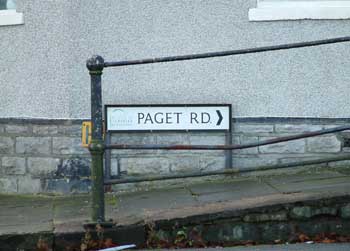
For a man who spends a good deal of his time hanging around with
poets John is a considerably political animal. His great-grandfather
ran a hauliers shifting stone from the quarries at Culverhouse Cross.
They lived at Great House, Ely. Moved there from the west country.
There's a photo of some of their workers in a steam-powered lorry
on John's landing wall. E. Osmond and Sons . Shirtsleeves. Weathered
faces leaning from a glass-less cab window. These origins are important.
John in a suit always looks uneasy. You get the feeling he'd prefer
to be out of doors somewhere shovelling earth or cutting wood.
John's books mostly circle the same subject: devolution. Wales apart.
Wales on its own. The Centralist Enemy. Creative Conflict. The
Divided Kingdom. Welsh Europeans. A Parliament for Wales. When
you have a good idea then keep it going. On his study wall is a framed
letter from fellow-Penarthian, Saunders Lewis, congratulating him
on the arguments proposed in The Centralist Enemy. The great and the
good recognised Osmond's strengths early on. His background is journalism.
When, in the sixties, he was offered two jobs simultaneously - working
for the Press Association at the House of Commons in London or hacking
as political correspondent for the Cardiff Western Mail - he found
choosing easy. This was the pivotal moment, he tells me. Do I become
a Brit, take the big one, and move to London, or follow my heart and
remain Welsh? He chose to stay local.
After a bruising campaign in support of devolution during the 70s
he launched the fortnightly political and cultural journal, Arcade.
That kept him quiet until the magazine failed in 1982. For the next
fifteen years he was first a journalist for HTV, then an independent
TV director, and finally deputy editor on the early broadsheet and
quite readable Wales On Sunday. But nothing ever really worked
for long. There were periods of drinking, periods of holding the head
in the hands. Everything I touch gets defeated, he once told Leo Abse.
But it is from your defeats you learn, was the reply.
And he did, too. He set up the networking organisation, the St David's
Forum, in the late 80s and became Director of the public policy research
think tank, the Institute of Welsh affairs, after that. Shirts, ties,
haircuts, interviews on television. A chairman to chide and guide
him. More books. Research reports. A quarterly magazine, Agenda, which
told the world what Wales was doing. The devolution highway. High-profile
dinners. Interventions. Consultations. None of which stopped him continuing
to consort with creative writers. At Welsh Union of Writers conferences
and Academi functions John can always be relied upon to either cavort
or collapse or both.
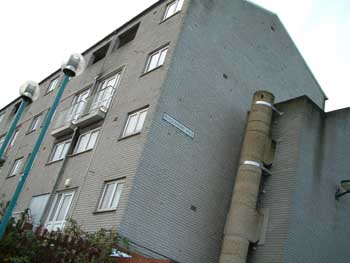
The Billy Banks flow west from Paget Terrace in an almost pristine
sixties line. They have that mid-century failed social solution look
about them. District heating stacks. Communal grass. Balconies. Grey
pebble dash. Connecting walls perforated by chequer-board laid bricks.
Today the flats themselves have largely been abandoned. There are
hundreds of them, named after a curious mix of Welsh and English royalty
- Prince Charles Court, Prince Llywelyn Flats, Prince Rhodri House.
The windows are boarded with ventilated metal, the doors blocked and
broken. Crap in the courtyards. Aluminium bell and intercom plates
belted by stones, dented out of their recesses. In their time the
blocks won prizes for their architecture. They also suffered the standard
sink estate disasters of asbestos, damp, leaking water systems, and
being belted out of shape just for the fun of it vandalism. They became
a ghetto for the municipal dumping of problem families. Punk music
like an electric saw day and night. Dope in the flowerbeds.
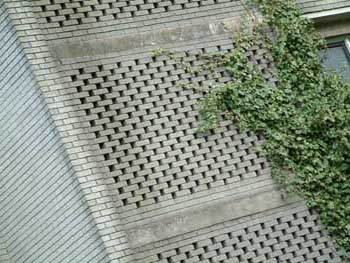
Most of the residents have been moved on apart from the fifteen or
so who bought under the right to purchase and remain. Spectres in
a disused land. We pass a washing line of black tee shirts strung
across overgrown shrubbery. Heavy metal amid the broken bricks. Below
us in a steep hillside of grass and bush are abandoned cars. Wrecks
crashed and burned when the flats were full. Glue-powered head bangers
hurtling their stolen Astras in an arc of noise and flame. Nature
reclaims them. They rust. Grass grows through their frames.
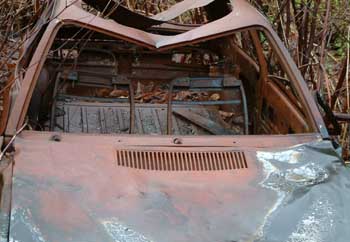
This whole area was once quarry - five separate gulches dug for limestone.
The spoil was tipped down the hillside by tramway into heaps - banks
as they were known. Beyond them lay the Taff Vale Railway coal yards
- officially the Williams Sidings. The Bowery kids clambered the banks,
the Billy Banks. All swept away when the flats were developed. And
soon the flats themselves. According to John they'll shortly be demolished
and the site marketed as Penarth Heights. Apartments. Marina View.
Sea Vista. Bay Boulevard. Exclusive. Certainly.
With his daughter, Morwenna, high on his shoulders John and I track
down through the mud and slip to Terra Nova Way. Edge of the Marina.
The speed-humped Penarth Portway. New terraces. Slim and bright painted.
Like Tenby. Barbeques smoke on the brick patios. Passion fruit climb
around glass doorways. Clean and bright but not really built for endurance.
Where will all this be in twenty years, asks John, pointing at the
nineties-style Barretesque arrivals. Are they going to stay the course?
Morwenna couldn't care less. She pulls at her father's hair. Behind
and above us is the Bowery. No one calls it that now. The residents
are all too civilised. History amended. Penarth is Penarth. No districts.
I can see the Assembly from my window, announces John. Do you go there
often, I ask, imagining him arriving at work by Bay traversing boat
or by walking along the Barrage. Hardly ever, he says. I get the information
I need from the internet. But for a devolutionist, it's nice to look
at the place, nonetheless.
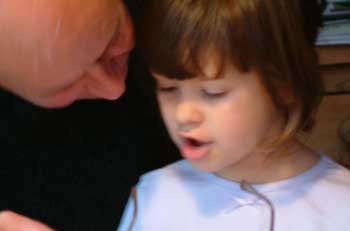
John Osmond explains
and Morwenna listens
Peter
Finch

back
to the top